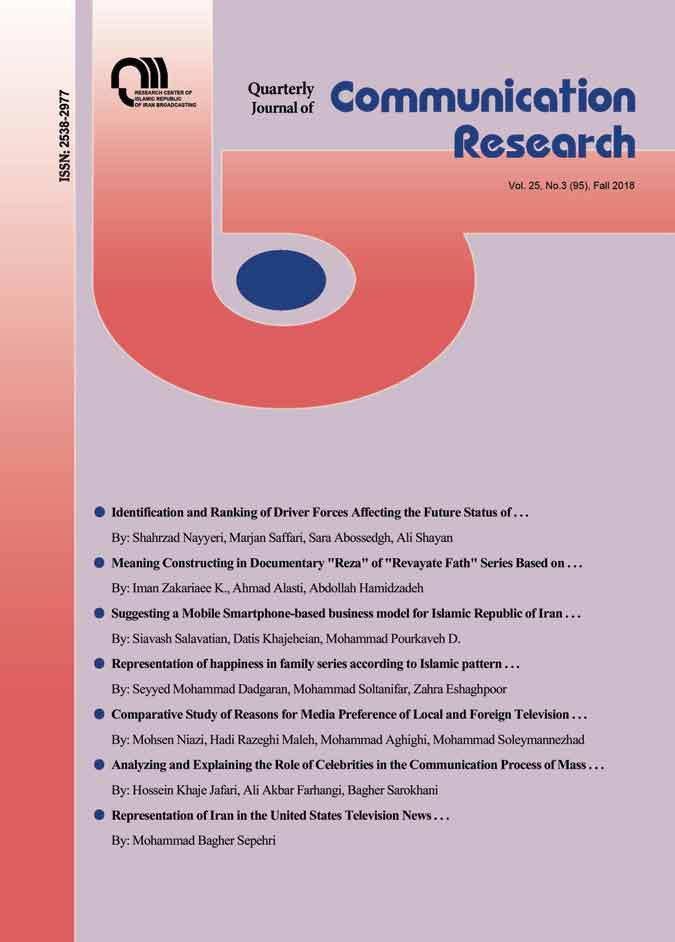Alborzi Da’vati, H. & Nasrollahi, A. (2018). Analyzing the effective trends and drivers on newsroom in the next 5 years. Journal of Communication Research, 25 (94), 103-127.
Ali, M.; Naderimanesh, M. & Nazemi, A. (2015). Future study on information technology in Iran in 2025 (2nd Ed.). National Research Institute for Science Policy of Iran.
Aliasgari, A. A.; Salavatian, S. & Alborzi Da’vati, H. (2014). Developing possible and preferable futures for national media (IRIB) in the Internet. Journal of Communication Research, 21 (77), 69-96.
Aziz Mohammadlou, H. & Mohammadnejan Madardi, S. (2016). The effect of environmental pressures on organizational performance with emphasis on choosing green technology (Case: Small and medium enterprises producing chemical dyes). Journal of Roshd, 13 (49), 41-48.
Babaei, M. (2013). Digital Media: Participatory and Technology-Driven. Science and Technology Discourse affiliated to Iranian Scientific Association of Information Management (ISAIM), 1 (2), 98-107.
Esmaeilian, M. (2016). A study on the regulatory strategies tailored to the future of audio-video media alternatives (Unpublished master's thesis). National Research Institute for Science Policy of Iran.
Hasannejad Kashani, B. & Nasrollahi, A. (2017). Identifying and categorizing the general policy of virtual space. Journal of Communication Research, 24 (4), 27-53.
Hejazi, A. (2010). The Future of information technology. Iran Future Association, 4, 3-10.
Information Technology & Digital Media Development Center affiliated to Ministry of Culture and Islamic Guidance. (2013). Digital publishing; definitions and criteria. Tehran: Kalam Khamoush Pub.
Information Technology & Digital Media Development Center affiliated to Ministry of Culture and Islamic Guidance. (2016). What is digital media? Retrieved from http://www.saramad.farhang.gov.ir/fa/intro/whatdm
Mazaheri, M. M. & Kafi, M. (2017). Futures studies of government and media. Journal of Rasaneh, 28 (3), 25-41.
Mousavian, S. M. (2011). Developing the space for the social network scenarios of soft war. Journal of Soft Power, 1 (1), 161-185.
Omrani, M.; Bahrami, M. & Shafiei, M. (2015). Foresight development of ICT infrastructure in cyberspace, with emphasis on the scenario method. Journal of Public Administration Perspective, 6 (1), 133-147.
Ra’naei, T. (2017). The state of the country's internal communications by the end of June 2017. Strategic Planning and Monitoring Deputy of the Ministry of Communications and Information Technology.
Shamaei, A.; Naderimanesh, M. & Ghadiri, R. A. (2015). Future study on information technology in Iran in 2025 (2nd Ed.). National Research Institute for Science Policy of Iran.
Sharifi, M. & Javaheri, J. (2015). Strategy Formulation for digital media in Iran with aim of cultural and religious influence on university students. Journal of Culture in the Islamic University, 5 (2), 163-182.
Soleimani, M. M.; Soltaninejad, H. & Pourmotahar, M. (2017). Jurisprudential investigation into virtual money. Journal of Islamic Finance Researches, 6 (2), 167-192.
Tavallaei, R. A. (2014). Futures study of Iran’s cyberspace services trends in the technological process of globalization, using delphi method. Journal of Strategic Studies of Public Policy, 5 (17), 93-123.

